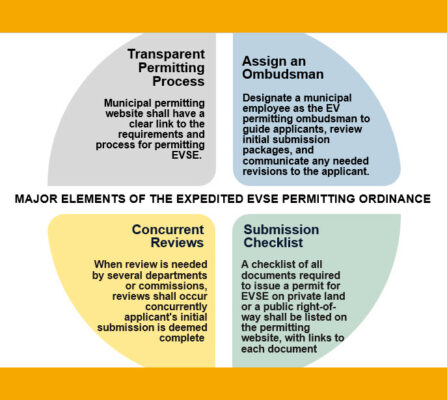by Susan Buchan
Are states, cities and towns prepared for the new electric vehicle infrastructure funding?
When Congress passed the Bipartisan Infrastructure Bill in November of 2021, it made history for including the largest-ever federal investment in transportation electrification. One section of the law, the National Electric Vehicle Infrastructure (NEVI) Formula Program, will provide $1B each year from 2022-2026 “to provide funding to States to strategically deploy electric vehicle (EV) charging infrastructure and to establish an interconnected network to facilitate data collection, access, and reliability.”
NEVI funding is slated for building a national EV highway charging corridor that will enable commercial fleet electrification and relieve range anxiety. Executed properly, this corridor could hold the key to transforming the US transportation sector from a serious contributor to greenhouse gas emissions to a model of innovative, clean transit. But are states, cities, and towns ready?
Permitting is Needed Now: How can we expedite?
For the vision of NEVI to be fully realized, permitting procedures for electric vehicle supply equipment (EVSE) need to be clear. And they must be implemented quickly.
Private, residential Level 1, 120V 1-Phase AC residential charging systems (e.g., for a two-car garage) and most private Level 2 EVSE almost never require a permit. However, public Level 2 and DC fast charging (DCFC) infrastructure can impact grid demand.
If placed in public rights-of-way, such infrastructure can require street openings/construction, trigger signage requirements, and need to be reviewed by boards and commissions. This process can take up to a year in complex sites. Currently only two states, California and New Jersey, have enacted legislation to require a standardized, streamlined permitting ordinance for EVSE to be adopted at the municipal level.
In many municipalities, only an electrical permit is required. While this might be completely adequate for a charging station installation on a private residential site, stations in certain locations trigger planning and permitting elements that are typically the purview of municipalities – lighting, landscaping, parking requirements and ADA access. Examples of these locations include:
- public parking lots
- shopping centers
- along public roadways
If a street opening is required (i.e., for a roadside installation along a public route), review by sewer and water commissions, coordination with other utilities, and obtaining a permit to close or alter traffic patterns come into play. These reviews can cause lengthy delays in installation, especially if reviews are not performed concurrently. Many cities and towns have simply not had enough experience with EVSE permitting to have a dedicated ordinance in place.
A Starting Point for Streamlining
E4TheFuture recently convened a task force to craft a Model Expedited EVSE Permitting Ordinance. Comprising utilities, EVSE installers, regional and local planners, and EV manufacturers, the group met to provide cities and towns with a template for adopting a streamlined permitting process.
While initially developed for Massachusetts, the Model Ordinance is meant to be revised to fit the needs of any permitting agency in any municipality.

Source: Model Expedited EVSE Permitting Ordinance slide deck
Other Considerations
While expedited permitting is a solid first step, there are also short- and long-term planning implications associated with the influx of EVSE in the next few years. Some of these are:
- If a charger displays advertising, is lit at night, or is large enough to affect driver visibility, planning departments may need to treat them as signage, and subject the stations to review for conformance with dimensions and zoning rules.
- Lighting may need to conform with dark sky regulations
- Landscaping may be regulated
Municipalities typically have master plans and ordinances tailored to reflect local environmental priorities and citizen desires. Are EVSE applications being reviewed for adherence to these regulations? Have first responders been trained to respond to EVSE emergencies? Has the groundwork been adequately laid for thousands of units of EVSE to be put in the ground, hung on walls, and suspended from telephone poles?
Long-term planning may require new parking lots to be EVSE ready, with underground wiring channels to ensure easy installation and future change out. Standardized EV charging area signage may be needed so drivers can recognize wayfinding aids anywhere they go.
Useful Resources
Overburdened local governments may not feel they are ready to embark on the journey to becoming an “EV ready” community. Fortunately, people have worked to create help for those starting out. The DOT and Virginia Clean Cities compiled EV readiness resources that provide a roadmap to a smooth transition to transportation electrification. It will be here before we know it!
–-Susan Buchan is Executive Director, Good2Go
